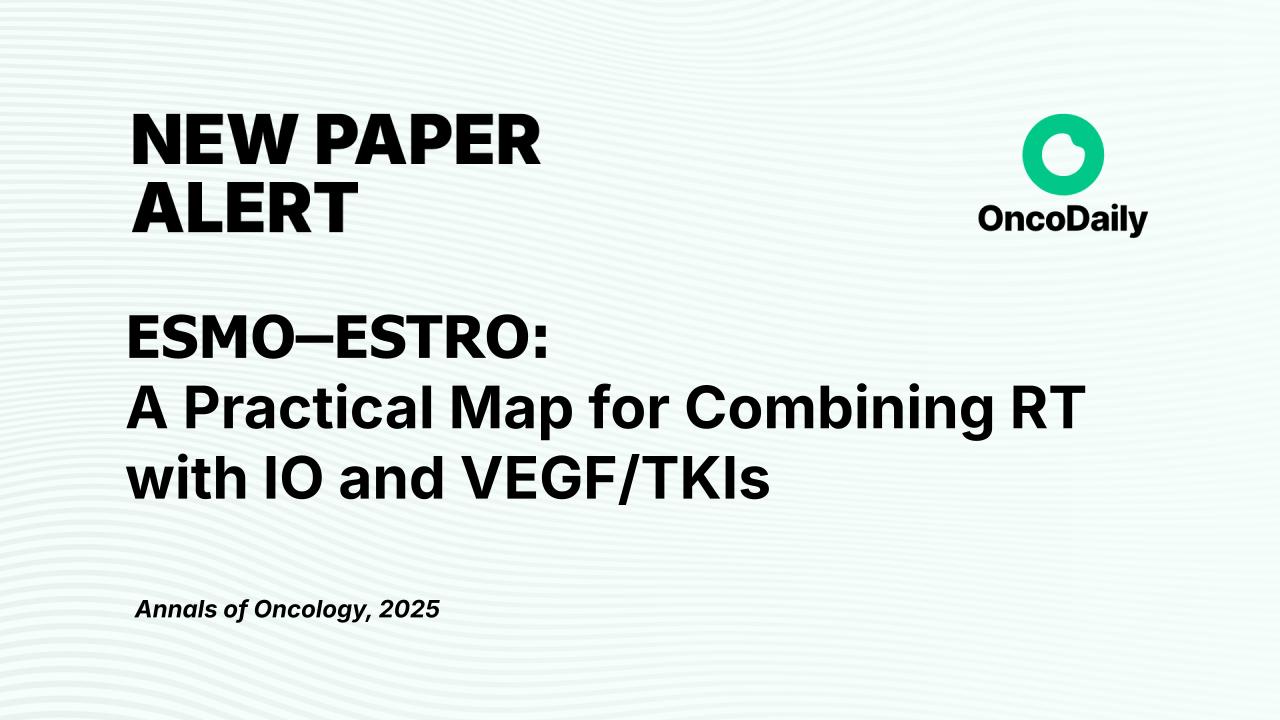On September 15, 2025, Annals of Oncology accepted a joint ESMO–ESTRO consensus paper that tries to answer a daily, practical question: when is it safe to combine radiotherapy (RT) with immune checkpoint inhibitors (ICIs), VEGF(R) inhibitors, or multitargeted tyrosine kinase inhibitors (TKIs)—and when should you back off? The project screened 5,921 records, included 159 reports, and ran a two-round modified Delphi with 20 international experts across 76 real-world scenarios; consensus was reached for 74 of them. The big picture: PD-(L)1 plus RT is usually fine with minor/no changes; VEGF(R) inhibitors and multitargeted TKIs require more caution, with specific red lines (e.g., ultracentral lung SBRT with anti-VEGF; sorafenib with high-dose liver RT).
The project’s governance sat with ESMO and ESTRO, coordinated by the Netherlands Cancer Institute, with monthly oversight meetings and predefined methods for evidence grading and consensus thresholds. Statements achieving ≥90% agreement are “strongly recommended”; those with 75–89% were accepted. The Delphi ran from September 19, 2023, to February 7, 2024.
Below is a clinician-facing synthesis that keeps the caveats in view: these are evidence-based safety statements, not prescriptive guidelines, and late toxicity data are often thin. Use them to plan care; don’t switch off your judgment.
How the Statements Are Meant to Be Used
The paper defines three safety levels that map directly to action at the console or in the chemo chair:
- Minor/no adaptation: combine as planned or with small changes (e.g., modestly more fractionation; more advanced RT techniques to lower normal-tissue dose). A short, clinically insignificant drug hold or dose tweak is acceptable if it won’t blunt efficacy.
- Major adaptation: meaningful drug hold/dose reduction, or a major RT change (≥20% lower prescribed dose to PTV and/or underdosing ≥20% of PTV). Timing aims to reduce drug levels before RT without long, efficacy-threatening gaps.
- Not combining: either skip RT or pause drug for ≥5 elimination half-lives before RT; consider restarting ≥1 week after RT, later if acute toxicity persists.
Each drug class is then cross-walked against six anatomic sites (skin, brain, head and neck, thorax, abdomen/pelvis, musculoskeletal) with those safety levels applied scenario-by-scenario.
PD-(L)1 and CTLA-4 Inhibitors with RT
Bottom line: PD-(L)1 inhibitors can be combined with RT across sites using minor/no adaptation. CTLA-4 sometimes needs major adaptation when RT dose is high, and dual ICI raises the bar further—though the extra RT-specific toxicity looks similar to CTLA-4 alone.
Toxicity signal to remember: the overall ICI+RT toxicity signal is modest, but watch the lungs and brain. Thoracic RT with PD-(L)1 pushes grade ≥3 pneumonitis to about 5.9% (95% CI 2.6–12.8). For brain RT, radionecrosis risk may creep up in some series, although data are mixed.
By region:
- Skin: no added risk beyond what RT or ICIs already cause alone.
- Brain: generally safe; keep radionecrosis on the radar.
- Head & Neck: no marked RT-toxicity increase seen with PD-(L)1; data sparse for CTLA-4.
- Thorax: no major red flag except the pneumonitis increment.
- Abdomen/Pelvis: GI flares are the theoretical concern (colitis/diarrhea), but severe events weren’t clearly increased.
- Musculoskeletal: no serious safety concerns.
Practical wrinkle: ICIs have long elimination half-lives and prolonged immunologic effects. That limits the usefulness of drug holds; when you need to mitigate risk, it often makes more sense to adjust RT (fractionation/technique) rather than playing calendar Tetris with the antibody.
VEGF(R) Inhibitors with RT
Bottom line: approach with caution—site, dose, and proximity to big vessels matter. The review screened 2,113 unique records and included 31 reports; across sites, the hazards that repeat are bleeding, wound issues, GI events, and vascular complications.
- Skin: moderately increased skin toxicity when bevacizumab is on board.
- Brain: combined therapy is often manageable and not an absolute contraindication, but intracranial and extracranial bleeding risk may increase; data on cognition and late effects are limited.
- Head & Neck: adding bevacizumab to concurrent chemoradiation can increase hemorrhage, lymphopenia, mucositis, and dermatitis.
- Thorax: esophagitis may increase; the key warning is G5 hemorrhage in ultracentral lung settings—both bevacizumab and ultracentral SBRT independently raise risk, and together the risk is concerning.
- Abdomen/Pelvis: higher risk of wound, GI, and vascular complications, especially with bevacizumab.
- Musculoskeletal: no clear RT-specific signal, but myositis may be more likely.
The upshot for safety levels: many VEGF(R) combinations won’t be “never,” but you’ll often favor major adaptation or, for high-risk thoracic scenarios (ultracentral SBRT), not combining.
Multitargeted TKIs with RT
Bottom line: this is the most heterogeneous group and the least well described. Expect more hematologic toxicity, watch GI/hepatic/mucosal signals, and be extra cautious with certain agents (cabozantinib, pazopanib, vandetanib) where data are sparse. Lapatinib is the notable non-VEGF TKI in the set, with mucositis concerns in head and neck RT.
By region (high-yield points):
- Head & Neck: lapatinib may increase grade 3–4 mucositis.
- Abdomen/Pelvis: sorafenib + liver RT is the classic trouble spot—excessive hepatotoxicity, especially with larger liver volumes; GI toxicity can also increase. Sunitinib adds a hematologic signal and possible GI effects.
- Musculoskeletal: marrow-related hematologic effects can stack up when irradiating larger fields.
Safety levels to apply: the panel advises major adaptation for most RT+multitargeted TKI combinations; minor/no adaptation can be reasonable for low-dose palliative RT to skin or musculoskeletal sites. Two clear “don’ts”:
- Do not combine with (ultra)central lung SBRT/SABR when large vessels, main bronchi, or esophagus receive high dose.
- Do not combine sorafenib with high-dose liver RT.
Key Recommendations (fast to apply)
PD-(L)1 + RT: proceed with minor/no adaptation in most scenarios; plan for slightly higher pneumonitis risk in thoracic RT; be mindful of radionecrosis after brain RT. If mitigation is needed, consider RT adjustments rather than long drug holds.
CTLA-4 + high-dose RT: consider a major adaptation for some schedules; recognize that dual ICI ups toxicity even if the incremental RT-specific risk looks similar to CTLA-4 alone.
Anti-VEGF + ultracentral lung SBRT: avoid the combination due to fatal hemorrhage risk; if thoracic RT is needed, rethink intent, technique, or timing.
Sorafenib + high-dose liver RT: don’t combine—excess hepatotoxicity, especially with larger irradiated liver volumes.
Multitargeted TKIs in general: lean toward major adaptation; minor/no adaptation is acceptable for low-dose palliative RT to skin or musculoskeletal targets.
When you must adapt, start with the RT plan: use more fractionation and more conformal/image-guided techniques (IMRT/VMAT/IGRT) to spare normal tissue; only small drug holds if they won’t threaten efficacy.
Remember the evidence gaps: many site–drug pairs lack high-quality toxicity data, especially for late effects; these statements guide practice but do not replace trials or registries.

Explore OncoDaily’s Special Feature On Targeted vs. Immunotherapy
Implementation Tips You Can Use Tomorrow
Plan the calendar with mechanism in mind. ICIs hang around. Long elimination half-lives and sustained immune effects limit the value of pausing for “a dose or two.” If you’re worried about pneumonitis or radionecrosis, adjust fractionation or spare critical volumes rather than banking on a brief ICI holiday to change risk in a meaningful way.
Define “major” versus “minor” changes up front. A “major” RT adaptation is not a small haircut—it’s ≥20% off the PTV dose and/or underdosing ≥20% of PTV by plan. If you find yourself needing that level of change to squeeze a combination through, pause and ask whether the combination is still the right call for disease control.
Reserve “not combining” for true collision courses. Examples: ultracentral lung SBRT with anti-VEGF agents; high-dose liver RT with sorafenib. In those cases, the panel suggests not co-administering and, if RT is non-negotiable, separating in time with an interval long enough (≥5 half-lives) to drop the active drug/metabolite concentration before RT.
Use site-specific red flags as triggers for MDT discussion. Head & neck with bevacizumab (bleeding/mucosal toxicity), thorax with anti-VEGF (hemorrhage), large liver volumes with sorafenib (hepatotoxicity), wide marrow fields with TKIs (hematologic toxicity). If one of those is on your agenda, pull in medical oncology, physics, dosimetry, and supportive care early.
Keep intention in view. The panel repeatedly emphasizes weighing toxicity against efficacy, and adjusting differently for palliative versus curative plans. A low-dose palliative field to bone with a TKI on board is not the same as definitive, high-dose RT to an ultracentral lung lesion with bevacizumab.
What This Is—and What It Isn’t
These statements are the first evidence-based ESMO–ESTRO safety recommendations at the RT–drug interface. They pull together systematic reviews and expert consensus to increase the level of usable evidence in clinic. But they’re not rigid rules, and they don’t replace registries or trials. The authors note low evidence levels for many combinations and a time gap between initial searches and the Delphi, which they partly mitigated by inviting experts to add newer literature when disagreeing. Agreement rates were high, suggesting the statements reflect current practice realities.
If you remember one thing: PD-(L)1 + RT is usually a green light with minor/no tweaks; anti-VEGF and multitargeted TKIs are where you must slow down, individualize, and sometimes say no. The consensus helps you decide which lever to pull—RT technique and fractionation first, drug timing only when it won’t undercut efficacy—and it marks the real danger zones (ultracentral lung with anti-VEGF; high-dose liver RT with sorafenib). It’s a practical, scenario-by-scenario playbook that should make tumor boards faster and RT plans safer, while we wait for better late-toxicity data and prospective trials.
Written By Aren Karapetyan, MD
